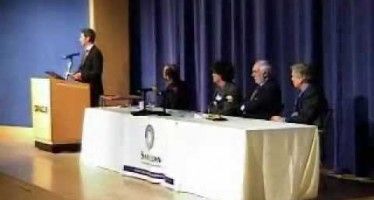Market closing Prop. 13 commercial property tax gap
Almost 36 years after it was passed by voters, controversy continues to swirl around Proposition 13, the 1978 tax limitation measure. Periodic calls to repeal or modify it, supposedly to gain more tax revenue, so far have gone nowhere.
The main objection is that it’s unfair because homeowners — and especially businesses — that have held their properties for decades pay less in property tax than new property owners. Prop. 13 assesses taxes at 1 percent of value, plus a maximum of 2 percent more per year due to property value increases and inflation. Property is reassessed when it changes owners, meaning new owners pay at what usually is a higher valuation.
However, currently the longstanding commercial property tax gap created is being rapidly reduced by the natural turnover of properties in the market. That is what the Los Angeles County Assessor’s Annual Report for 2013 indicates. (See the graph on p. 12 of that document.)
The percentage of commercial properties with old base-year assessments has dropped from 75.5 percent in 1980, to 33.0 percent in 1990, and to 16.3 percent in 2013.
This would make superfluous the calls for more initiatives on the ballot that would create a “split roll” tax. It would also avoid future politically charged over-assessments from a split roll tax. A split roll property tax is where commercial properties are reassessed more frequently or at higher tax rates than residential properties.
Trend
If this trend continues, the percentage of old assessments for both single family residential properties and commercial-industrial properties would reach 0 percent by 2020; and residential income properties that have old reassessments would be reduced to less than 2 percent (see table below).
This trend is still reducing the percentage of properties in Los Angeles County with old base-year assessments. From 2012 to 2013, the percentage of commercial properties with old-base years dropped a full 0.5 percentage point, from 16.8 percent to 16.3 percent. Similarly, single-family residential properties with old base year assessments declined from 13.6 percent to 13.1 percent from 2012 to 2013. It should be understood that this is an extrapolation of the data trend over the last 33 years and not a guarantee of any future natural increase in property tax revenues.
Percentage of Properties With Old Base Year Assessments – LA County
| Year |
Single-Family Residential |
Residential Income |
Commercial & Industrial |
| 1980 |
63.1% |
60.5% |
75.5% |
| 1990 |
28.8% |
29.0% |
33.0% |
| 2013 |
13.1% |
14.0% |
16.3% |
| 2020 extrapolated |
-0.17% |
1.71% |
0.33% |
| Source: LA County Assessor Annual Report 2013. | |||
Market and Prop. 13 resulting in rising property taxes
The factors causing assessed property values to rise in 2012 were as follows:
- Properties sold/ transferred — $20.28 billion (38.6 percent);
- Inflation adjustment under Prop. 13 — $17.23 billion (32.8 percent);
- Decline in value and other adjustments — $10.37 billion (19.7 percent);
- New construction — $2.95 billion (5.6 percent);
- Special property use types — $1.59 billion (3.0 percent);
- Business, personal property and fixtures — $0.90 billion (1.7 percent).
Increased real estate market sales, new construction, and the value adjustment provided by Prop. 13 comprised 77 percent of the rise in assessed values. Thus, the market and Prop. 13 are making any split-roll property tax proposal unnecessary.
Additionally, the impartial California Legislative Analyst has forecast that local property tax revenues will rise from $16.8 billion in fiscal 2014-15 to $24.6 billion in 2019-20, a $7.8 billion “windfall” due to the housing market recovery. The LAO has also forecast a $2.2 billion state general fund budget surplus for the 2013-14 fiscal year.
Third rail
A third rail powering electric trains carries hundreds of volts of electricity. Anyone who touches the third rail usually dies from electrocution. “Third rail” political issues are similarly “charged.” And for three decades, Prop. 13 has been the biggest third-rail issue in California.
Despite that, state Assemblyman Tom Ammiano, D-San Francisco, has vowed to bring a bill to create a split-roll property tax in 2014. Such a bill likely would put the matter before voters as an initiative. Ammiano insists Prop. 13 is no longer the third rail for politicians. Instead, he maintains, “It’s more like the bad guy with the mustache who has tied California to the rails with the fiscal train wreck coming.”
That seems to be confirmed by a public opinion poll released in May 2013 by the Public Policy Institute of California. It found that 58 percent of voters favored a split-roll property tax.
But that was without any real initiative on the ballot; and without the intense campaign against such an initiative that inevitably would be launched by such anti-tax groups as the Howard Jarvis Taxpayers Association.
Should a split-roll initiative appear on the November ballot, the anti-tax groups would have some heavy ammunition on their side, including: The emerging state budget surplus and LAO forecast of a “windfall” in property tax revenues by 2019 from a housing market recovery.
And the trend in assessed property values in Los Angeles County, showing that a split-roll wouldn’t bring in much higher revenue.
Related Articles
Arnold aide: AB 32 will have no effect on global warming
John Seiler: Arnold’s beloved AB 32 is a jobs killer. Yet its imposition would have no effect on global warming,
7 years not enough planning time for air board on AB 32
May 16, 2013 By Chris Reed The news that Gov. Jerry Brown wants to “borrow” $500 million in cap-and-trade auction



